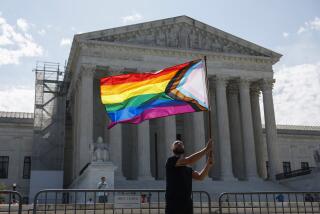Later Marriage Has Census Looking Like ‘Friends’ Cast
- Share via
WASHINGTON — Still unmarried at 30, Art Green is a certified public accountant who plays hockey, lives in Boston by himself and hangs out, like the characters on the television sitcom “Friends,” in a succession of apartments with other single folk.
Green, who figures he will marry sometime in the next five years, is one of millions of Americans driving up the median age of first marriages to a historic peak of 26.7 for men and 24.5 for women. The U.S. Census Bureau reported those statistics Tuesday.
A source of wonderment and consternation to his parents, Green is a member of one of the nation’s largest and fastest-growing groups, never-married adults, who account for almost a fourth of Americans older than 18.
In 1994, there were more than 44.2 million never-married adults in the United States, which is more than twice the number in 1970. While many appear to be forgoing marriage altogether, most of the growth in the group has come from people like Green, who are delaying wedding dates in the interest of finishing school, launching careers or finding perfect mates.
And in a development made to order for producers of meals-for-one, singles like Green are living alone in greater numbers. From 1970 to 1994, the number of men older than 15 living alone mushroomed from 3.5 million to 9.4 million, an increase of 167%, according to the census. And 14.2 million women older than 18 are living alone. That’s almost double the number of women who lived alone in 1970.
Those figures are part of a new portrait of the American household issued by the Census Bureau on Tuesday and fleshed out in a report by the respected Population Reference Bureau Inc. Both reports depict a dramatically changed family that may have begun to stabilize in its new patterns.
Carol J. DeVita, a demographic analyst at the Population Reference Bureau, suggests that the welter of new numbers indicates that families are “plateauing into a new norm.”
“We had tremendous, radical change in what our families looked like in the 1970s and 1980s,” said DeVita. “We have settled into a new norm. And that norm is two parents working outside the home, an older age of marriage, a leveling-off of divorce. It is a blended family, with ex-spouses and ex-grandparents, half siblings and stepchildren. Maybe we’re catching our breath and saying: ‘This is what the American family looks like now.’ ”
Some census figures offer a revealing glimpse of the family:
* The rate of divorce has declined slightly and may be leveling off. In 1994, there were 4.6 divorces per 1,000 people, which is the same as in 1993 and slightly lower than the rate of 4.7 per 1,000 people in 1990. But that’s still more than double the rate in 1960.
* By 1993, nearly a third of all births in the nation were to unwed mothers but the rate of increase in out-of-wedlock births had begun to slow. During the 1980s, such births increased 6% per year. By the early 1990s, however, the pace of growth had slowed to 2%.
* The growth of single-parent families, which reached a 6% annual rate in the 1970s, also slowed to 3% in the first half of the 1990s.
* The number of two-parent, married-couple households with children has increased by 701,000, reversing a 20-year pattern of decline.
Much of the slowdown in changes may be because the baby boom generation is entering its stable years of nest-building and child-rearing, demographers said.
More to Read
Sign up for Essential California
The most important California stories and recommendations in your inbox every morning.
You may occasionally receive promotional content from the Los Angeles Times.














